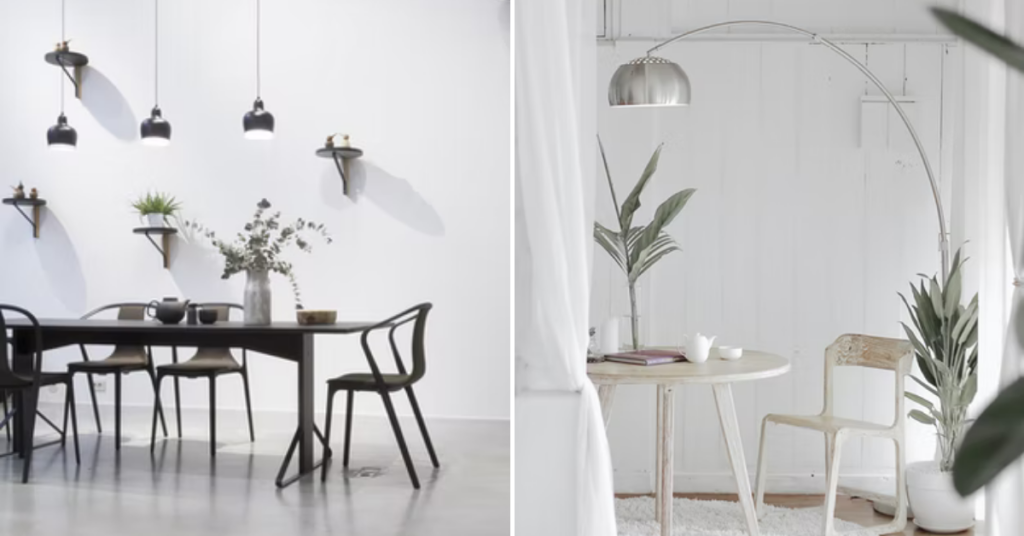When it comes to designing concepts, there is a plethora that is exceptionally precise to your tastes such as the ever so beloved- minimalism. The notion of minimalism, which entails reducing things to their most basic form, is now widely understood. It may be used in a variety of settings, including art and lifestyles, as well as architecture and interior design. With that, Glitz is talking all about minimalist interior design and how you can decorate your furniture to achieve your desired aesthetic.
Minimalist interior design is related to modern interior design in that it focuses on employing only the minimal necessities to create a clean and uncluttered environment. Simplicity, clean lines, and a monochrome palette with colour utilised as an accent characterise it. It generally consists of an open floor plan, plenty of natural light, and utilitarian furniture, with a focus on the shape, colour, and texture of a few key items.
How To Style Minimalist Furniture
Contents
Clean lines

Functionality and practicality are the hallmarks of minimalist furniture and accessories. Flat, smooth surfaces and strong, clear lines make forceful statements that emphasise each item’s importance.
Highly patterned furnishings and accessories, as well as highly intricate decoration, are not present. Instead, the attention is on the shape and form’s purity and simplicity. Clear and clean benchtops and surfaces, bare walls with few artworks, and the removal of clutter, such as stacks of documents and collections of knick-knacks, are all important elements in creating a minimalist room.
Bare essentials

To generate a sensation of freedom and relaxation, the minimalist style employs only the basic elements: light, shape, and attractive materials, generally in an open-plan structure. There isn’t a lot of extraneous embellishment or decoration. Instead, the few details that are employed are simple and mix in well with the environment. This might be a single piece of artwork on a living room wall or a lovely vase on top of the dining room table.
Quality over quantity

Working with a pared-back aesthetic is difficult because of how little you have to work with. This complicates the decision-making process considerably more than normal. You must carefully analyse each piece before allowing it into the space, but the ultimate product is tastefully selected. Your objective is to create an environment in which anyone would want to spend time.
Therefore, impulse purchases of popular products that you will quickly weary of are incompatible with minimalist design. Choose items that are well-made, will endure a long time, and will improve the appearance of your home.
Declutter surfaces

These must be cleared if you actually want to adopt the minimalist design appearance and feel. Ask yourself what you can get rid of, what you can store out of sight, and what you don’t need, and then prioritise your belongings. Maintain consistency in this procedure by revisiting each room every few months with fresh eyes.
Each time you simplify anything, you’ll see that there’s more you can do. Give everything a designated area and stick to it to keep your surfaces clean.
Determine a neutral base

It’s all about the foundation hue when it comes to constructing a classic minimalistic environment. However, just because traditional minimalism is colour-averse doesn’t mean it has to be dull or uninteresting. In fact, the best simplicity is the polar opposite.
White paint with yellow undertones seems warmer and creamier, whereas white paint with blue undertones appears sharper. Because a room with a lot of natural light may appear warmer, choose a cooler shade of white to balance it out.
Keep it simple

Maintain a straightforward approach. Reduce the amount of stuff you have and stick to the “less is more” philosophy. Don’t believe, though, that your new decor needs to be dull. The minimalist design may be lovely, warm, rich, and welcoming when done effectively.
Play around with texture

A minimalistic space with neutral tones might feel chilly or uninteresting, but there’s one sure-fire way to make it feel warm and inviting: texture. For that much-needed comfort element, turn up the heat with knitted blankets, beaded pillows, sheepskin rugs, and velvet décor. While restraint is normally recommended, feel free to let your imagination run wild with these sensory triggers. However, combining too many textures, materials, and surfaces of various hues will almost certainly give you a headache.


















